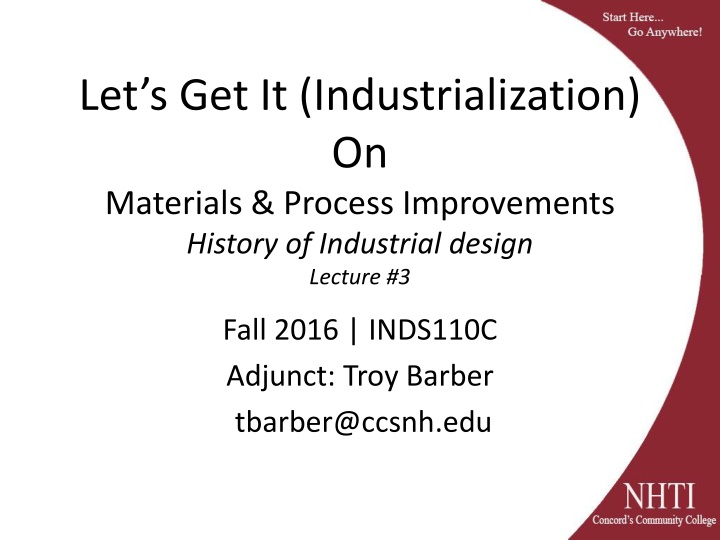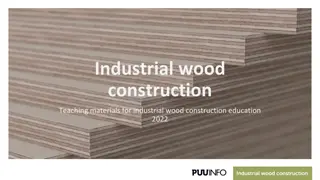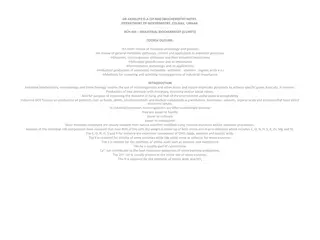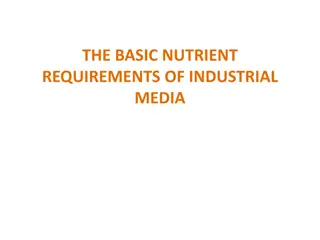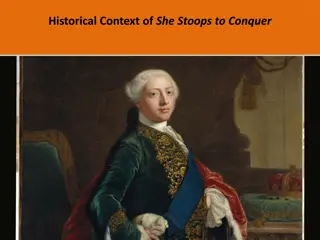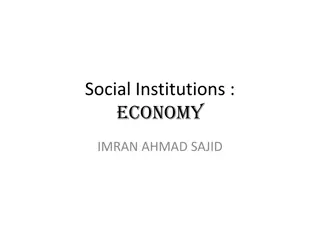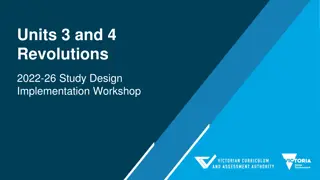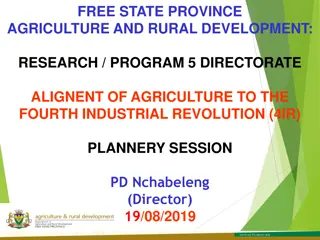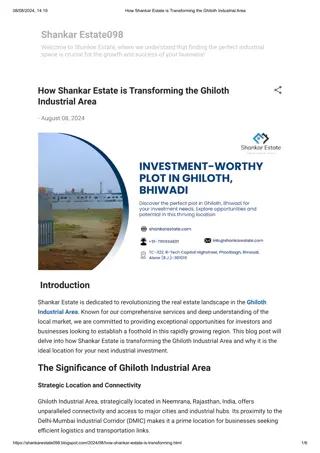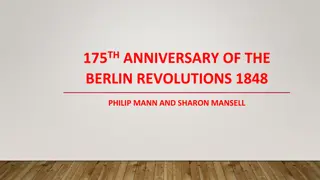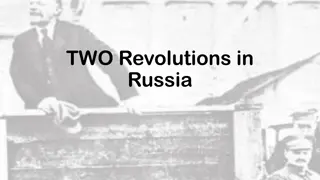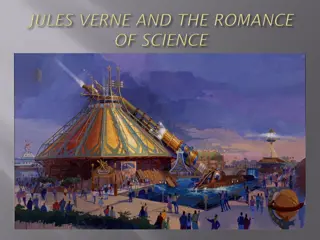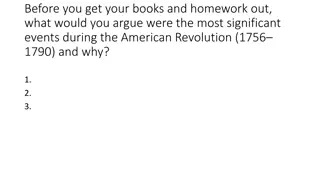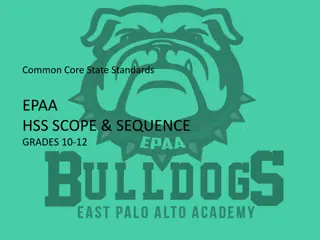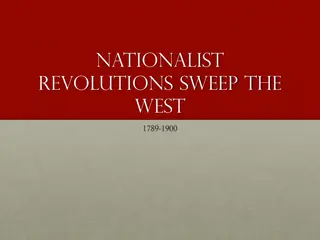Industrial Revolutions: Transforming Materials and Processes in History
The First Industrial Revolution (1760-1820/1840) marked a shift to machine-based manufacturing with new chemical and iron production processes. It saw the rise of factories and textiles as a dominant industry, originating in the UK. The Second Industrial Revolution (1820/1840-1910) further advanced in the United States with innovations in steel production, transportation, and infrastructure, transforming industries and enabling new technologies and developments.
Download Presentation

Please find below an Image/Link to download the presentation.
The content on the website is provided AS IS for your information and personal use only. It may not be sold, licensed, or shared on other websites without obtaining consent from the author.If you encounter any issues during the download, it is possible that the publisher has removed the file from their server.
You are allowed to download the files provided on this website for personal or commercial use, subject to the condition that they are used lawfully. All files are the property of their respective owners.
The content on the website is provided AS IS for your information and personal use only. It may not be sold, licensed, or shared on other websites without obtaining consent from the author.
E N D
Presentation Transcript
Lets Get It (Industrialization) On Materials & Process Improvements History of Industrial design Lecture #3 Fall 2016 | INDS110C Adjunct: Troy Barber tbarber@ccsnh.edu
First Industrial Revolution(1760-1820/1840) Primarily in the UK, then spread to Europe & USA Machines replaced hand production methods New chemical manufacturing and iron production processes Improved efficiency of water power and steam power Rise of the factory system Textiles were the dominant industry in terms of employment, value of output, and capital invested The Industrial Revolution began in Great Britain and most of the important technological innovations were British.
Second Industrial Revolution(1820/1840-1910) United States, then Europe, Japan, etc. Labor + Land Labor was in comparative short supply in the United States, which promoted mechanization Land continued to open to the west, and improvements in transportation technologies improved trade and expanded markets Erie Canal completed in 1825 Connected the Hudson River to Lake Erie Reduced shipping costs to the inland United States by 95% Five (5) places where mule trains or wagon roads could pass through the Appalachians The Erie Canal helped to open the interior of the United States to population growth
Second Industrial Revolution(1820/1840-1910) United States, then Europe, Japan, etc. Erie Canal
Second Industrial,Revolution(1820/1840- 1910)--Steel United States, then Europe, Japan, etc. Advanced in metallurgy made iron even cheaper to produce Steel could be made from molten pig iron in greater quantities and much cheaper Iron + Carbon + Chromium, etc. = stronger + better tension and compression properties Cheap steel allowed building larger bridges, railroads, skyscrapers, and ships. Steel cable, steel rod and sheet steel enabled large, high-pressure boilers and high- tensile strength steel for more powerful machinery. More powerful engines, stronger gears and axles, more powerful guns, more durable carriages, and naval ships. Example: in the early 1860 s steel rails replaced iron rails that formerly had to be replaced every 3-6 months Iron rails were as good as new after 6+ years typically lasting 10x what iron did. Rail transportation became the dominate mode of transportation for decades
Second Industrial Revolution(1820/1840-1910) Railroads United States, then Europe, Japan, etc. Steel rails made cheaply caused rail lines to explode in popularity between 1843-1860.
Second Industrial Revolution(1820/1840-1910)- Machine Tools United States, then Europe, Japan, etc. Mechanization required more metal parts, e.g. wooden gears absorbed moisture, changed shape, etc. Early tools were made from cast iron or wrought iron by hand. Lacked precision, slow, and expensive. Steel machine tools could be made to tolerances of +/-.0001 Screw threads could be standardized, meaning that a particular type of threaded fastener could be mass produced and would always fit. The drive for standardization and interchangeability was largely driven by firearms and martial pursuits.
Second Industrial Revolution(1820/1840-1910)- Other United States, then Europe, Japan, etc. Other Significant Advancements Cheap paper, cheap (rotary press) printing (1840 s) Petroleum (1848): lubrication & fuel use Chemistry advancements (1856): Synthetic dyes Maritime Advancements (1830 s): Steel, engines not wind, etc. Vulcanized Rubber (1840 s): Tires, etc. Bicycles (1870 s) Automobiles (1888): First, not the best Electrification (1880 s)
Grant Information Get IT is sponsored by a $2.5 million grant from the U.S. Department of Labor, Employment & Training Administration TAACCCT Grant #TC-26498-14-60-A-33 NHTI, Concord s Community College, is an equal opportunity employer, and adaptive equipment is available upon request to persons with disabilities. This workforce solution was funded by a grant awarded by the U.S. Department of Labor s Employment and Training Administration. The solution was created by the grantee and does not necessarily reflect the official position of the U.S. Department of Labor. The Department of Labor makes no guarantees, warranties, or assurances of any kind, express or implied, with respect to such information, including any information on linked sites, and including, but not limited to accuracy of the information or its completeness, timeliness, usefulness, adequacy, continued availability or ownership.
NHTI information and Attribution NHTI, Concord s Community College 31 College Drive Concord, NH 03301 www.nhti.edu Creative Commons Attribution 4.0 International License INDS 110C History of Design curriculum by Troy Barber is licensed under the Creative Commons Attribution 4.0 International License. To view a copy of this license visit http://creativecommons.org/licenses/by/4.0/deed.en_US. http://creativecommons.org/licenses/by/4.0/deed.en_US
